Written by: David, Deep Tide TechFlow
The crypto market has its own 'boy who cried wolf' story.
On August 3, First Squawk, a well-known foreign financial news platform, released a message on social media: 'China has officially banned cryptocurrency transactions, mining, and related services, citing financial risks, capital flight, and environmental impact'.

And Investing.com and Rawsalerts, overseas financial giants with millions of followers, have successively forwarded this unconfirmed 'breaking news'. Obviously, talking about China banning cryptocurrencies has become a 'traditional skill' of cryptocurrency market fake news.
In the comment section of the news, there is a funny comment ---Grok, tell me, how many times has China banned cryptocurrencies?
Old investors are already aesthetically fatigued with this kind of fake news, and the price of Bitcoin is already immune to it.
However, the crypto market does have an absurd cycle --- every once in a while, there will always be a very influential piece of fake news.
You can be immune to the China ban cycle, but you may not be immune to the emergence of all fake news. When enough people believe that a certain piece of fake news will affect the price, it really will affect the price.
China's 'ban' is just the tip of the iceberg of the entire crypto market being affected by fake news. Looking back at the entire history of the crypto market, those heavyweight fake news have also truly affected the trend of crypto assets;
Behind a piece of fake news, you can even see a secret information transmission chain.
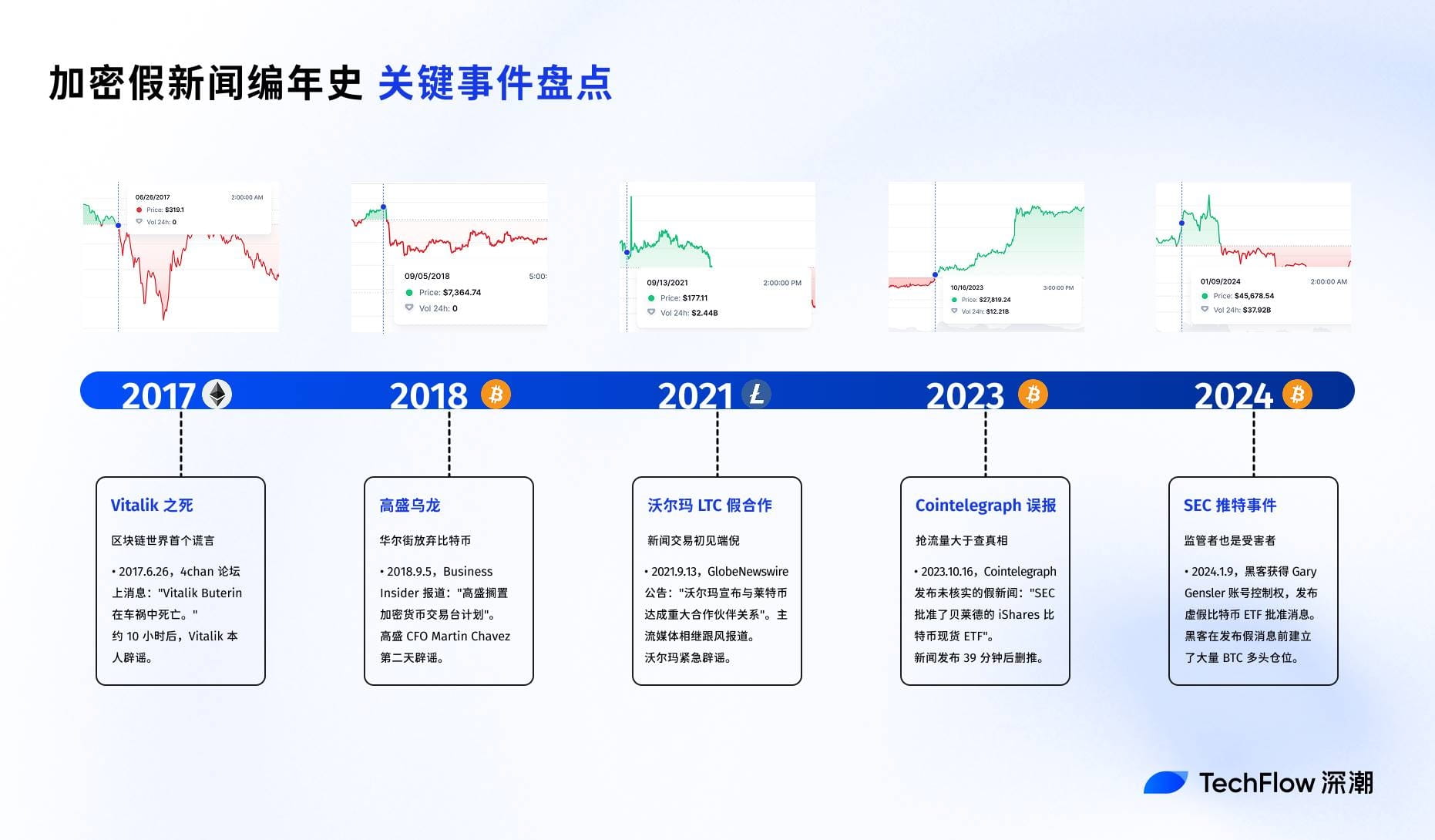
Chronicle of Crypto Fake News: From Amateur to Professional, Key Events Review
2017: The Death of Vitalik, the First Lie in the Blockchain World
If you were to write an evolutionary history of cryptocurrency fake news, June 26, 2017, would definitely be a milestone.
That afternoon, a message appeared on the well-known foreign forum 4chan: 'Vitalik Buterin died in a car accident.' There was no source, no evidence, and not even decent details.
But it was such a rough rumor that triggered the first market crash in cryptocurrency history caused by fake news in the next few hours. ETH at the time fell from $317 to $216 in 6 hours, a drop of nearly 32%.
Reddit's r/ethtrader section is filled with posts like 'Is this real?' and 'Can anyone confirm?'. In Telegram groups, coin holders are debating whether to sell immediately.
After the rumor spread for about 10 hours, Vitalik himself dispelled the rumor by posting a photo of himself holding the Ethereum block number and hash value of the day on Twitter, proving that he was still alive with the blockchain itself.

V God is still alive, but your position may be gone.
The market's reaction at the time revealed a cruel truth: in the early wild west of the crypto world, an anonymous post can be as destructive as an official announcement.
Early fake news creators were mostly amateur players. They either created so-called insider groups on Telegram, or posted on forums like 4chan. This is a market with extremely asymmetrical information, and retail investors are groping in the dark, and any disturbance can cause a stampede.
The fake news of this period is more like a spoof by a few people, tied to the founder of the project; the market directly links the personal safety of the founder with the survival of the project.
2018: Goldman Sachs Oolong, Wall Street gives up Bitcoin
And when fake news puts on a suit, professional 'exclusive news' is even more destructive.
On September 5, 2018, the cryptocurrency market was in the shadow of a bear market. At this sensitive moment, Business Insider, a well-known American business website, published a report with a headline that hit the nail on the head: 'Goldman Sachs shelves plans for a cryptocurrency trading desk'.
The so-called 'Trading Desk' is the department of an investment bank that buys and sells specific financial products for clients. If Goldman Sachs really set up a cryptocurrency trading desk, it would mean that its institutional clients could buy and sell Bitcoin through Goldman Sachs, which was regarded as an important milestone for cryptocurrencies to gain mainstream recognition at the time; and 'shelving' means that cryptocurrencies are being abandoned.
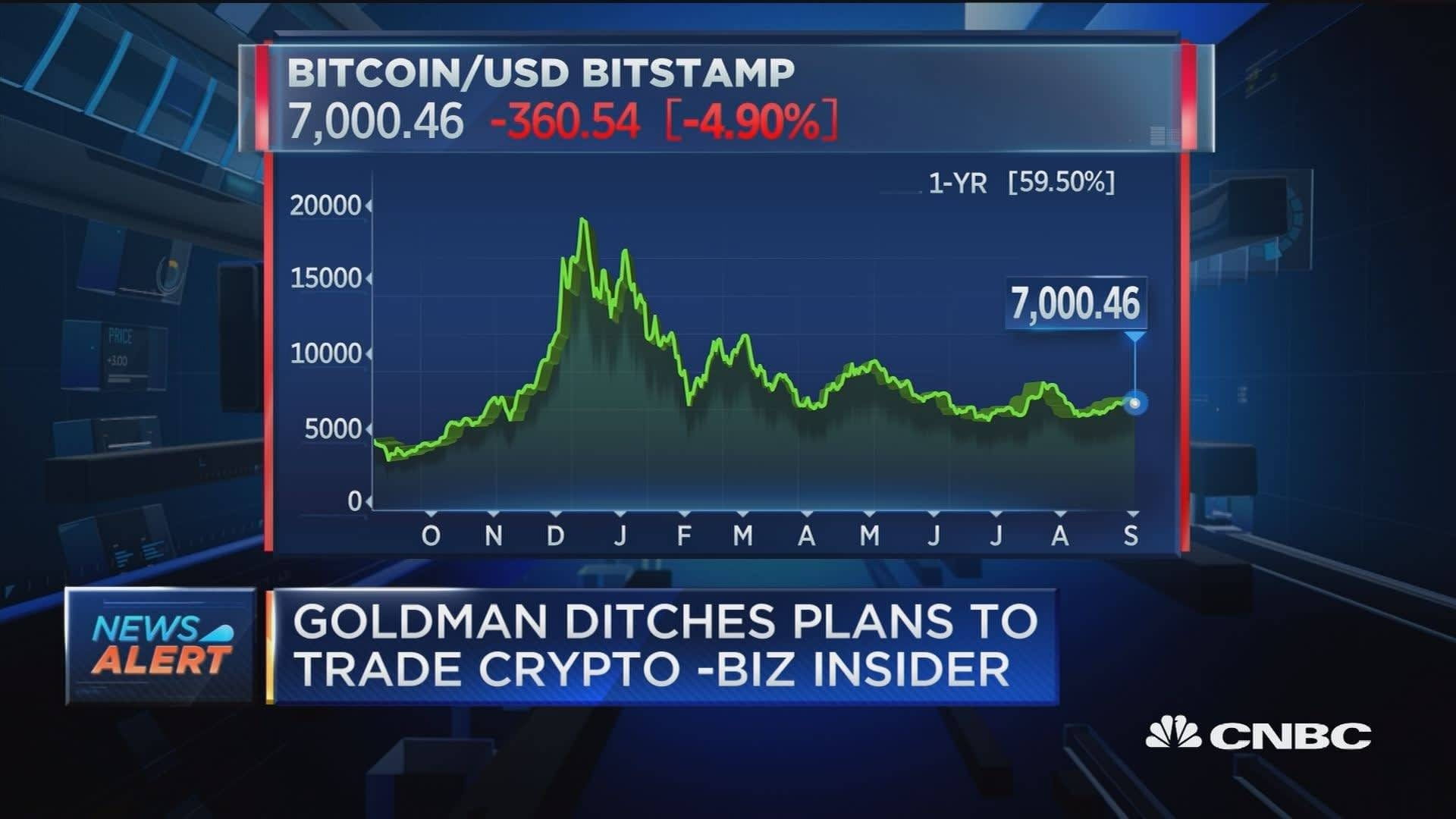
The next day, the plot took a turn. When Goldman Sachs CFO Martin Chavez was asked about this at the TechCrunch conference, his answer stunned everyone: 'I was wondering yesterday when I made this decision? This is fake news.'
But the clarification came too late. In those 24 hours of panic, a large number of investors had already cut their positions and left the market.
According to Cointelegraph's report at the time, Bitcoin and other digital currencies plummeted in price after this fake news, which was said to have originated from 'internal sources', with the total market value falling by $12 billion in one hour, of which Bitcoin fell by more than 6% on the day.
2021: Fake Cooperation between Walmart and Litecoin, News Trading Appears for the First Time
If the previous fake news may have been misunderstandings or negligence, then the fake news about Walmart's cooperation with Litecoin on September 13, 2021, was a complete premeditated crime.
At 9:30 that morning, an announcement appeared on GlobeNewswire, one of the world's largest press release distribution services.
The title was eye-catching: 'Walmart Announces Major Partnership with Litecoin'. The press release was well-produced and contained all the elements of a professional press release: Walmart's official logo, detailed cooperation plans, executive quotes, and even contact information for the investor relations department.

The press release claimed that starting October 1, all Walmart's e-commerce websites would offer the option to 'pay with Litecoin'. It also quoted Walmart CEO Doug McMillon as saying: 'Cryptocurrency will play an important role in our digital strategy.'
Subsequently, some crypto media began to rush to report this information, and the most important thing is that the official Twitter account of the Litecoin Foundation retweeted this news.
In that era when there was no 'coin-stock linkage' and crypto was not so popular, the market's reaction was quite explosive.
The price of Litecoin began to rise vertically, and trading volume surged. Mainstream media also joined the communication chain - CNBC and Reuters reported successively; by 10:30 that day, the price of Litecoin reached its peak, with an increase of more than 30%.
However, just as the market was reveling, Walmart's public relations team discovered an anomaly. After urgent verification, they issued a statement: this is a false message, Walmart has no cooperative relationship with Litecoin.
After the news reversed, the price of Litecoin fell like a free fall. But for the behind-the-scenes manipulators, the game was over.
Subsequent investigations found that in the 48 hours before the fake news was released, there were abnormal Litecoin bullish option trades on the market. The manipulators made millions of dollars in this scam through careful planning.
The terrible thing about this incident is its professionalism.
From registering similar domain names, creating fake press releases, to choosing the timing of the release and using official accounts to endorse it, every step is carefully calculated. This is not like the prank of fabricating Vitalik's death at the beginning, but a more premeditated and organized crime, trying to profit through news trading.
2023: Cointelegraph Misreports, Prioritizing Traffic Over Truth
October 16, 2023, is a day worth reflecting on for the cryptocurrency media industry.
At 1:17 PM, a screenshot from a Telegram group began to circulate in the crypto community. The screenshot showed that a message appeared on the Bloomberg Terminal interface, claiming that the SEC had approved BlackRock's iShares spot Bitcoin ETF.
For cryptocurrency investors who have been waiting for many years, this is undoubtedly a historic moment.
Cointelegraph's social media team saw this message. As one of the largest cryptocurrency media in the world, they certainly know the weight of this news.
But before publishing, they faced a dilemma: spend time fully verifying, risking being preempted by other media? Or publish immediately to seize the traffic high ground?
At 1:24 PM, just 7 minutes later, Cointelegraph posted this 'breaking news' on its official X account. The tweet was very eye-catching: 'Breaking: SEC approves BlackRock spot Bitcoin ETF'.
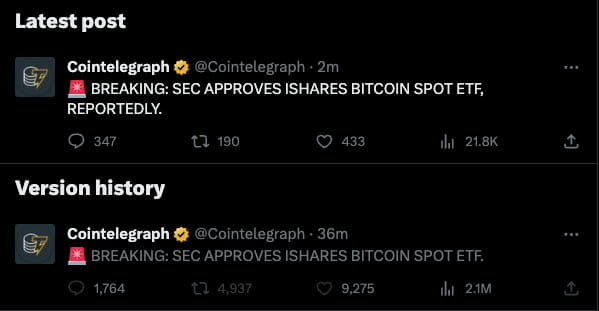
The market's response was immediate and dramatic, with Bitcoin's price soaring from $27,900 to $30,000 in the next 30 minutes, a gain of over 7%; trading volume instantly amplified, and the servers of major exchanges felt the pressure. The derivatives market was even more crazy, with $81 million in short positions being forcibly closed in this surge.
However, the excitement quickly turned into doubt. Careful observers began to raise questions:
Why is only Cointelegraph reporting? Why is there no announcement on the SEC's official website, and why is BlackRock keeping silent?
At 2:03 PM, 39 minutes after posting the tweet, Cointelegraph deleted the original tweet. But the damage had been done. In less than an hour, the market experienced a complete cycle of ups and downs.
According to the investigation report subsequently released by the media, the error stemmed from the loss of control of internal processes - the social media editor violated the rule that editing confirmation was required before publishing.
This incident sparked heated discussions in the industry. One sharp view is that when the media puts speed above accuracy, they are no longer media, but tools for market manipulation.
Crypto media is under immense pressure. It's a 24/7 market, and news can break at any time. If you're 5 minutes late, someone else will steal the traffic. In this environment, publishing first and verifying later is a risky but highly rewarding choice, but it may also come at the cost of credibility.
In traditional financial markets, major news is usually released uniformly through official channels and there are strict information disclosure rules. But in the crypto market, information channels are decentralized and it is difficult to distinguish between truth and falsehood. A screenshot or a tweet can trigger billions of dollars in capital flows.
Ironically, when the SEC actually approved the Bitcoin ETF in January 2024, the market's first reaction was not to cheer, but to be skeptical.
2024: SEC Twitter incident, regulators are also victims
In January 2024, the SEC's official X account released fake news of Bitcoin ETF approval. According to subsequent investigations by the FBI, the attackers gained control of the account through a SIM card swap attack. The price of Bitcoin rose from $46,600 to $47,680 after the fake news was released, and fell to $45,627 after the rumor was dispelled.
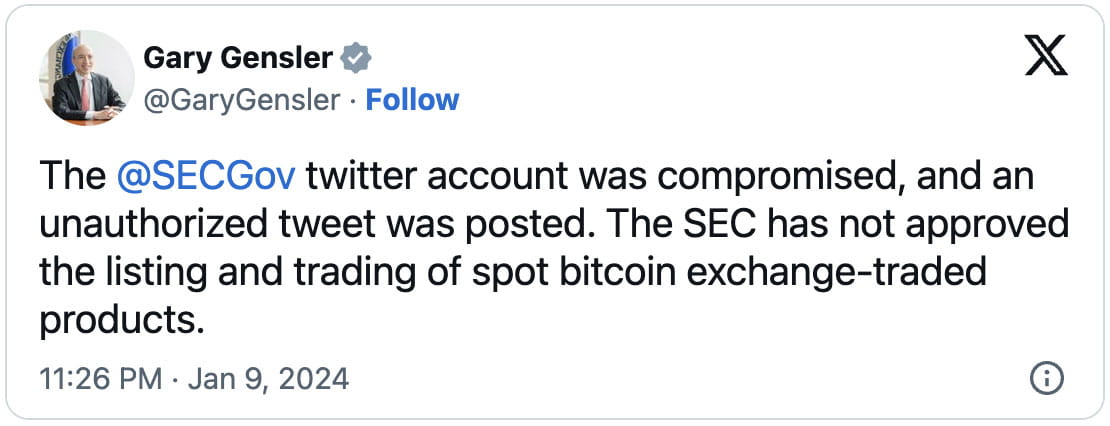
In October 2024, the FBI arrested the suspect, Eric Council Jr. Court documents show that this was a premeditated financial crime, and the attacker had established a large number of Bitcoin long positions before releasing the fake news.
In the past decade, cryptocurrency fake news has completed the transformation from 'unintentional mistake' to 'deliberate crime'. The technical threshold, the scale of funds, and the degree of organization are all being upgraded. You may have avoided a certain piece of fake news, but there is no guarantee that you will not fall for it next time.
Three men make a tiger, when the truth is diluted
In the crypto market, tracking down the source of fake news is often futile.
When news such as 'China bans cryptocurrencies again' stirs up the market, a large number of forwards, algorithm recommendations, and increased self-media discourse power make it impossible for anyone to say where a piece of information originally came from.
A typical crypto fake news dissemination path can be like this:
The first-level source is usually a small Telegram channel or Discord group, and it is almost impossible to trace the source. Publishers often use anonymous accounts, and there is no loss even if they are exposed;
The second layer of small circles fermented and circulated among several related groups, and began to add 'corroboration' - photoshopped pictures, fabricated details, and seemingly logical reasoning, etc.;
The third layer of crypto media platforms gives the message a 'quasi-official' color. Even if disclaimers such as 'according to sources' are used, readers often selectively ignore them.
The fourth layer KOL intervenes, when the news spreads to a certain extent, KOLs face a choice: to publish or not to publish? Most choose the strategy of 'forwarding but not endorsing' - using words such as 'it is said' and 'there are reports'.
Fifth layer market reaction, once the price starts to fluctuate, the fake news gets 'market verification'. The drop itself becomes 'evidence' of the veracity of the news.
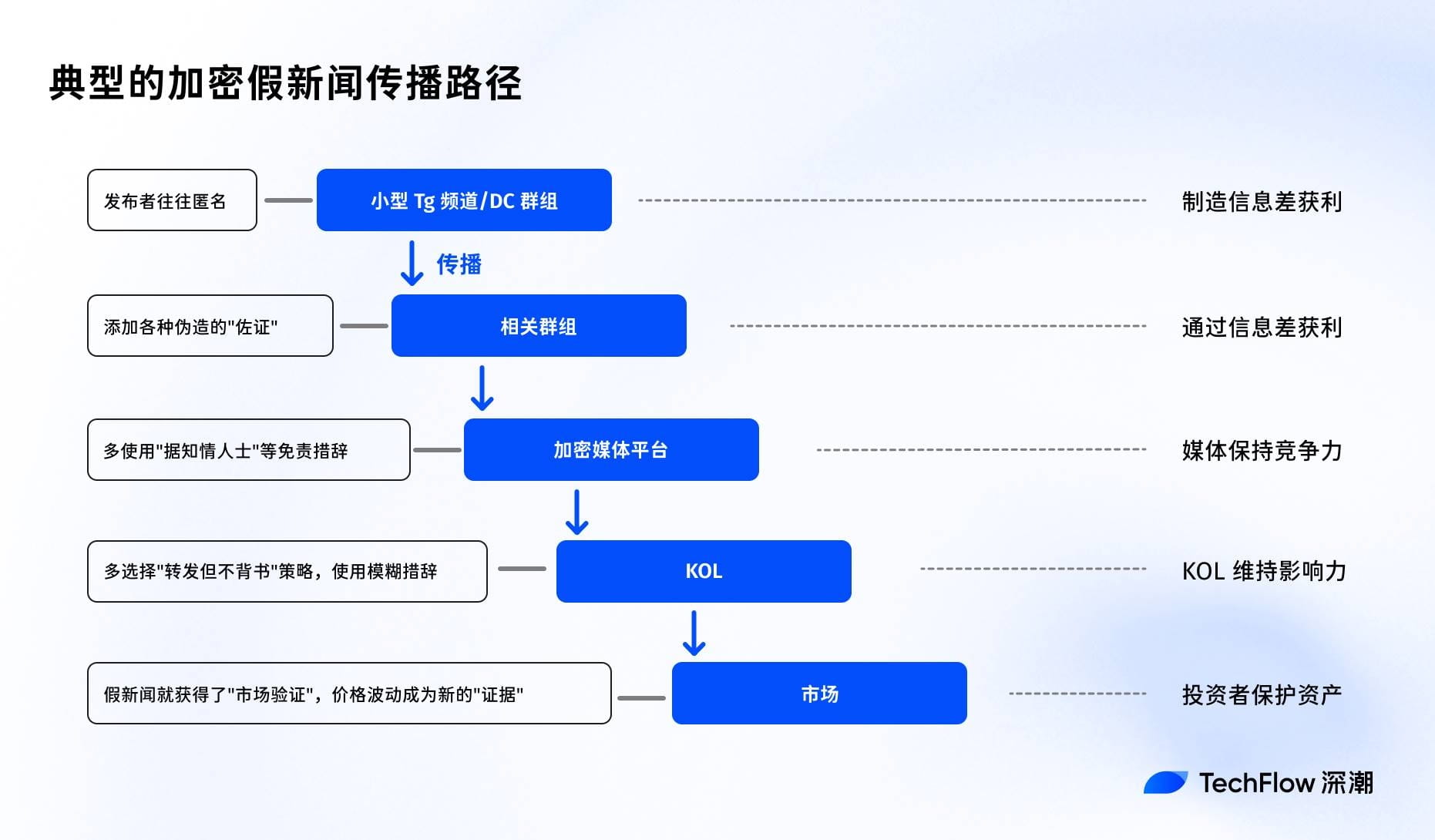
When a message is spread through multiple layers, tracing the source becomes almost impossible. Each layer of communication adds new 'details' and introduces new interpretations, until the original information is completely diluted.
In the crypto market, rumors can spread irresponsibly and quickly, but dispelling rumors requires rigorous evidence and logic. Spreading panic/exclusive news may bring trading opportunities, but spreading rumors has no direct benefit.
Every participant is acting rationally according to their own interests, but all these 'rational' choices add up to create a collectively irrational result.
The market is repeatedly fooled by fake news, but it seems that no one can or is willing to break this cycle.
Perhaps this is the new meaning of 'three men make a tiger' in the crypto era: it's not that it will become true if three people say it, but when enough people believe that it will affect the market, it really affects the market.
In this process, the truth itself becomes less important.



